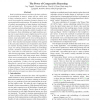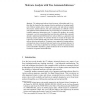52 search results - page 9 / 11 » Binary codes from the line graph of the n-cube |
SP
2009
IEEE
14 years 1 days ago
2009
IEEE
Malware authors have recently begun using emulation technology to obfuscate their code. They convert native malware binaries into bytecode programs written in a randomly generated...
ICCV
2011
IEEE
12 years 5 months ago
2011
IEEE
Rank correlation measures are known for their resilience to perturbations in numeric values and are widely used in many evaluation metrics. Such ordinal measures have rarely been ...
TIT
2010
13 years 17 hour ago
2010
We directly lower bound the information capacity for channels with i.i.d. deletions and duplications. Our approach differs from previous work in that we focus on the information ca...
ICSE
2008
IEEE-ACM
14 years 6 months ago
2008
IEEE-ACM
When software developers want to understand the reason for a program's behavior, they must translate their questions about the behavior into a series of questions about code,...
CAV
2011
Springer
12 years 9 months ago
2011
Springer
Abstract. The underground malware-based economy is flourishing and it is evident that the classical ad-hoc signature detection methods are becoming insufficient. Malware authors ...


